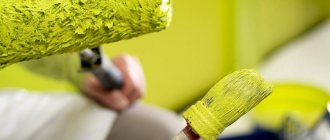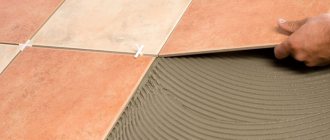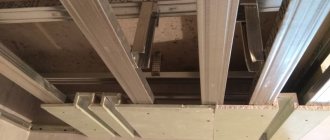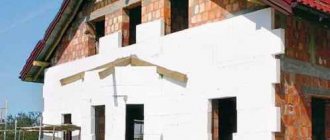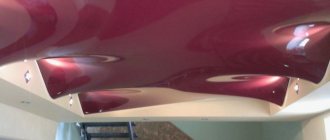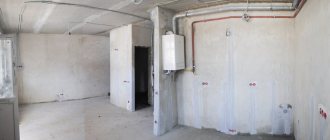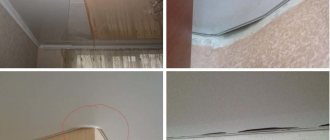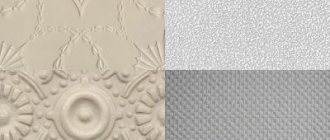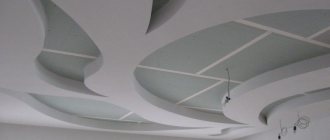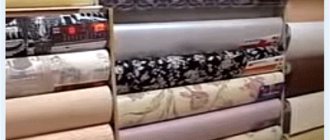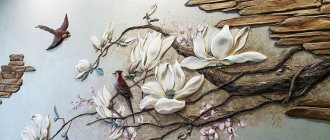Which ceiling to choose
It’s not for nothing that there are so many types of ceilings - each of them solves certain problems, meets its own criteria and tastes of different people. But such a huge selection and availability of most materials can be confusing - you want both this and that.
But this surface is finished once every few years, and it’s good if over the years it doesn’t get boring, doesn’t deteriorate, and doesn’t go out of fashion. Is there a design that meets these requirements? Yes, there is one!
An example of versatility
A common option that fits into most interior styles is a matte white surface. At the same time, it should be smooth, without drawings or stucco.
There are many types of materials that can look like this. This includes drywall, paint, plaster, and even suspended ceilings of a certain texture. Here the choice depends on what budget you have allocated for repairs, how long you are willing to wait and how much inconvenience you are willing to endure for the sake of the result.
In what cases can complex ceilings be made?
Designers most often recommend adhering to the principle “the simpler the better,” but there are exceptions:
- If the decoration of the room and the furniture in it are neutral both in color and shape, the ceiling can, and sometimes even needs to be made unusual. But if the room already has enough accents, then the top should be more modest.
- In large rooms, multi-level structures look great, zoning the space and making each part more separate. The shape of the ceiling depends on what is located on the floor and walls. For example, you can lower the ceiling above the bed. In this case, rearranging the furniture will be much more difficult, so its location needs to be carefully thought out.
- Ornate designs overhead - various waves, flowers and butterflies - will not soon become relevant. In modern interiors, simple geometric shapes are more common - square, rectangle, circle, semicircle, oval, triangle. Multi-level ceilings of similar shapes are used when it is necessary to correct the irregular shape of a room. In this case, their use is justified.
Types of material
Gluing photo wallpaper on the ceiling is much more difficult than on the walls, because you have to work at heights in a not very comfortable position. Based on this, manufacturers have developed a number of types of similar finishes. Thanks to a fairly wide range of these materials, the customer will be able to choose the most suitable option for himself, taking into account the microclimate, layout and general style of the interior of the room. To create not only a beautiful, but also a practical and durable room design, all the above points must be taken into account.
The following types of photo wallpaper for the ceiling are on sale:
- Paper
. Lightweight products that are easy to glue. To provide additional protection for paper-based strips, they are laminated with a special coating. The finished finish is quite sensitive to moisture, steam, temperature fluctuations, etc. The main advantage of this type of photo wallpaper is complete environmental friendliness. - Plastic
(polyvinyl chloride based). An excellent option for decorating rooms with high levels of moisture. The strips are small in size, which makes them easier to stick. As a rule, plastic photo wallpapers imitate various natural materials - wood, plaster, stone, etc. - Textile
. Available in a wide variety of textures. This material is not prone to absorbing odors and tolerates moisture well. Bright and clear images are used as an aesthetic design for textiles. Most often they are used to decorate ceilings in the kitchen. - Velor
. Presented in a huge assortment of colors, textures and applied themes. Pleasant to the touch, but afraid of moisture. For this reason, there is a restriction on the use of velor photo wallpaper in the bathroom, kitchen, toilet and hallway. - 3D Wallpaper
. Special finishing, which is made from various materials. This makes it easier to select realistic and three-dimensional images for any interior. Most often, 3D wallpaper for the ceiling is used in bedrooms or living rooms.
As a rule, the ceiling surface above the recreation areas - places where sofas, folding chairs, and beds are placed - is equipped with photo wallpaper. This allows you to enjoy beautiful images while lying down.
Whitewash, paint and plaster
To paint, whitewash or plaster the surface, you will have to tinker, but the height of the walls will remain the same. These finishing options are suitable for most styles - classic, modern, historical, rustic, ethnic.
Lime and chalk
Despite the fact that the range of finishing materials is becoming larger and larger, the good old whitewash has not gone away. Its composition is very simple - it is an aqueous solution of slaked lime or an aqueous solution of chalk. The characteristics of these solutions differ. Lime has the following properties:
| Pros of lime | Cons of lime |
| Hides minor surface defects well | The color is white, but not bright |
| Has bactericidal properties | It smells unpleasant during the whitewashing process, but after drying there is no smell |
| Resistant to moisture | May cause allergies |
Chalk has its advantages and disadvantages:
| Pros of chalk | Disadvantages of chalk |
| Paints ceilings and walls bright white | It does not have the same masking qualities as lime, so the surface will have to be more carefully prepared for whitewashing |
| Has a neutral odor | Not bactericidal |
| Hypoallergenic | Not suitable for wet environments |
IMPORTANT . If the ceiling has already been covered with lime, then in the future you need to use such a solution. And if the surface is covered with chalk, then the new layer should be chalk. But chalk and lime are incompatible.
Dye
Water-based matte paint is best suited for painting the top - it is odorless and dries quickly. As for preparing the surface for painting, people here are divided into two camps - supporters of perfectly smooth ceilings and those who calmly paint directly over concrete or rough putty. But there shouldn’t be any controversy here - it’s just that some trends in interior design really allow for slight negligence.
Plaster - textured and structural
Textured plaster allows you to create the desired relief on a layer that has not yet dried. Only those specialists who have at least some artistic abilities should be involved in such work.
And the pattern of structural plaster manifests itself during the process of applying the solution. This happens thanks to the special components in its composition.
Careful leveling of the plane is not required - plaster will hide the imperfections. This coating is environmentally friendly and durable.
This decorative plaster on the walls and ceiling creates the illusion that the house is built of sand
Installing photo wallpaper for the ceiling
Photo wallpaper for the ceiling is glued in the same way as regular paper wallpaper. In this matter, it is important to take your time and adhere to a certain technology. As always, when starting work on ceilings, you will need to bring the basic, rough ceiling surface into proper shape.
Note: One important note. Paper photo wallpapers are thin and have a delicate structure, so before gluing, the surface of the ceiling must be brought into a perfectly flat and smooth state. Otherwise, when smoothing the panels, you risk damaging the design.
Using plaster and putty, all unevenness is leveled and obvious surface defects are eliminated. When working with plasterboard installed on the ceiling, it is necessary to carefully putty the mounting points and joints with putty.
The process of gluing photo wallpaper to the ceiling is carried out according to the chosen scheme. Each fragment of a single plot is a separate panel that must be glued in a clear sequence. For example, in most cases you can glue photo wallpaper with a view of the sky onto the ceiling without keeping the elements of the picture matching. Whereas photo paintings or frescoes on ceilings will require you to strictly adhere to the sequence of stickers for each panel, taking into account the marking scheme.
There are four types of markup, with complex and simple layouts. For example, the first picture shows the simplest marking scheme used for gluing ordinary paper wallpaper with a simple pattern.
With complex markup the situation looks different. Using a level, a grid is applied to the ceiling with the number of cells corresponding to the number of photo wallpaper panels. The dimensions of the cells must be the same as the dimensions of the panels.
Note: manufacturers often number each fragment of a large photograph, so when marking, you can number each cell in accordance with the panel numbering indicated on the products.
This is what the markup with numbering looks like.
During gluing, do not allow the panels to get wet. Otherwise, you will have to spend a long time fiddling with smoothing out wrinkles and stretching the fabric over the joints. The pasted sheets are smoothed with a roller or rag, from the front edge to the junction with the next panels. We begin gluing the pattern on the ceiling, starting from the flattest panel.
Wallpaper
Let's look at some types of wallpaper suitable for ceilings.
Paper, vinyl, non-woven and textile
Paper wallpaper is the most budget-friendly. And if the choice falls on them, then it is better to prefer two-layer ones - the image on them can be either flat or convex. Paper is the most environmentally friendly and breathable finishing material, but that’s where its advantages end.
Non-woven wallpaper is divided into two subtypes - completely non-woven and combined. The latter have only a non-woven base, and the outer side can be vinyl or some other.
BY THE WAY. Wallpaper consisting entirely of non-woven fabric can be painted, and more than once.
Vinyl wallpapers are denser, but they are rarely painted. In addition, this type of canvas is not recommended for use in the kitchen - it absorbs odors.
Textile wallpaper looks cozy and presentable, but you should not try to glue it yourself without experience.
ADVICE. If you have to choose between wallpaper and paint, experts advise taking into account the age of the house. New buildings shrink during the first few years and microcracks appear on the surfaces. And good wallpaper can hide them. And it is better to use paint in houses that are more than 5 years old.
If the ceiling is high enough, choose a large wallpaper pattern - then you can examine it in detail
Liquid wallpaper
This material is a dry mixture of textile fibers and cellulose. Before applying to the surface, the mixture is diluted with water. The advantages of liquid wallpaper are the absence of seams and maintainability. If any area is damaged, it can be “patched” with the remaining mixture.
BY THE WAY . The design of fillets—plinths made of foam plastic or other materials—helps to achieve a neat boundary between the ceiling and the wall.
Liquid wallpaper can be tinted yourself if the desired shade is not available for sale.
Ceiling pasting
Pasting
The work can be done in several ways, but I use this:
- First, I cut the canvas to the required length. I do this with a reserve, calculating in advance the length required to join the pattern.
Cutting strips with scissors or a knife
- Then I mix the glue, leaving it to swell for a while. It is advisable to make the adhesive composition a little thicker - this way it will not drip.
Instructions for diluting the composition must be indicated on the packaging
- I take a roller and apply glue to the base. I treat an area slightly wider than one strip of trellis and leave it for 10-15 minutes.
- I lay the strip of wallpaper on a clean, flat surface and apply the adhesive mixture to the backside. I leave it for two to three minutes so that the liquid is absorbed into the base.
Applying glue
- I fold the strip in half or four (accordion-style) and transfer it to the place where it is to be glued. There, with the help of an assistant, I lift the wallpaper to the ceiling and apply one edge to the base.
We fold the canvas in two for carrying
Apply the canvas to the base and straighten it
- Working together with a partner, we gradually unfold the strip, trying to initially place it as needed. We adjust the position of the material until the glue sets.
Pasted first strip
- We level the canvas with our palms or a spatula, expelling air bubbles to the edges. After that, I take a roller with a long handle and roll the material for better adhesion.
- Separately, use a small roller to roll the seams and edges of the strips. Sometimes it is worth adding more glue to these areas.
Rolling a seam with a roller
Then you need to proceed according to the same scheme, laying adjacent panels end-to-end, without overlaps, gaps or displacements of the ornament.
Final work
Having covered the entire surface of the ceiling, we leave the wallpaper for some time for the glue to dry.
After this we perform the final operations:
- Using a sharp knife and a ruler, level or wide spatula, trim off the excess around the perimeter. It is advisable to do this after the surface has completely dried - wet paper (and other materials) are disgusting to cut.
Trimming excess
- Check the surface for air bubbles. If we still missed a few, we carefully pierce them and release the air, pressing the material to the base and carefully smoothing it out.
- If the material requires painting, we paint the wallpaper with interior paint using a roller or spray gun.
- Along the perimeter we seal the junction of the ceiling and the wall with a border or install a ceiling fillet.
The result of the work. Wide shaped molding fits perfectly into the overall concept
Facing materials
The cladding will hide unevenness well, and will take away quite a bit from the height of the room. Materials for the top differ in their properties from those intended for walls. Firstly, they should be as light as possible. Secondly, strength is not so important for them.
Ceiling tiles
The advantages of this three-dimensional tile imitating molding are its low weight and low price. This material may look beautiful, but is often used to save money and time. The tiles are installed quickly - just glue them to the surface with special glue. At the same time, it must be applied carefully - only to the middle of the tile - without allowing it to leak out along the edges.
Expanded polystyrene tiles come in three types: pressed, laminated and seamless. Laminated is a suitable option for the bathroom and other wet areas. Seamless is good for the living room and other living rooms. Pressed tiles are the most fragile.
IMPORTANT. In kitchens with a gas oven, any polystyrene foam tiles will quickly lose their appearance.
The most common type of ceiling tile
Brick
Real brick is used only for the construction of vaults. But the facing is also suitable for decorative finishing of the top. Alternative options are also used - from drywall, plaster or carved foam.
Brick can be painted any color
Stretch ceilings and their types
Such designs come in handy when you need to do work quickly and relatively cleanly, and at the same time hide communications, install lamps and protect the room from flooding. You will have to pay for these amenities with the height of the walls - they will become at least three centimeters lower.
Let's consider different types of such surfaces.
Glossy
Varnish, or glossy, PVC ceilings are a very popular solution. They are reflective, which means they make the room brighter and visually higher. But they don’t look good in every interior. An exception may be styles such as high-tech - here gloss will emphasize the idea of manufacturability.
Black gloss reflects the chandelier, making it seem more voluminous
Matte and satin
If your goal is to create a surface similar to a classic one, give preference to a matte texture. Satin also looks almost natural and only slightly reflects the light falling on it. This is a compromise between a glossy and matte surface.
This matte cream-colored stretch ceiling is almost indistinguishable from painted
Stretch ceilings protect the room from flooding from above
Suede
The upper, trimmed with suede, looks interesting in rooms furnished in ethno, baroque, classic or retro style. Even in a large room, such decoration will create an intimate atmosphere. There are also materials that imitate leather.
Such a bright suede ceiling needs space
With photo printing
The photo printing technique allows you to apply any design to the canvas at an affordable price. But it is better to use this opportunity carefully. In the vast majority of cases, such ceilings look out of place, especially if an ordinary photo is chosen as the image, and not a work by an artist.
If you want a salamander on the ceiling - no problem, photo printing can do that too
carved
Such surfaces with a 3D effect do not go unnoticed. Here two or more canvases are combined. What is below has shaped holes through which the first layer is visible. A huge number of design and color options allows you to create both a real masterpiece and something that will add to the collections of “anti-trends” on YouTube.
Flying swallows - a suitable image for a carved ceiling
Mirror
Unlike glossy samples, which loudly declare that they are tensioned, mirror ones look like real mirrors. Only they are darker, but absolutely unbreakable. Their already sufficient decorativeness can be enhanced by applying patterns to them. For example, abstract matte lines or pictures
There should be order in a room with mirror surfaces
This video shows the so-called “floating” tension structures. Lighting plays a big role in creating this effect:
Types of photo wallpaper
It is not easy to decide which photo wallpaper to choose for the ceiling, since today they are presented in a large assortment.
Paper photo wallpaper for the ceiling
Despite the emergence of new materials, paper wallpaper continues to remain the most popular finishing materials. First of all, they are an environmentally friendly finishing method and have a low cost. By giving preference to paper-based wallpaper, you will not only save money, but also refresh the room.
Textile photo wallpaper
The basis of their production is natural silk and linen threads or fibers. They are all characterized by excellent performance characteristics: moisture resistance, resistance to change. Therefore, such coatings can be successfully used not only in residential premises, but also in the kitchen.
Velor wallpaper can be distinguished as a separate type. This is a great option for decorating a nursery or living room.
Photo wallpaper on the ceiling with 3D effect
Such wallpapers are represented by canvases with three-dimensional images applied to the surface. The basis is a paper web, one of the sides of which is laminated with a matte or glossy texture, which makes the coating moisture resistant. Similar 3D wallpapers are slightly inferior in price to textile coverings.
You can select any picture as an image. There are ready-made wallpapers of this type on sale that are glued to the ceiling without requiring the use of additional decorative elements. Depending on the purpose of the room, you can choose canvases depicting animals, flowers, cosmic and celestial scenes. A large number of variations will allow you to choose the optimal solution for any interior.
Vinyl photo wallpaper for the ceiling
Their structure consists of two layers:
- The top one is polyvinyl chloride.
- The bottom one is non-woven or paper.
Manufacturers offer three types of such finishes:
- Foam material without embossing. It is characterized by an unusual convex texture that hides minor irregularities in the ceiling.
- Fabrics obtained by hot stamping. Imitate natural materials.
- Flat vinyl - designed for finishing flat ceilings.
PVC photo wallpaper
They are made from PVC sheets, onto the surface of which an image is applied. Due to the moisture resistance of the material, it can be used for finishing ceilings in bathrooms.
The standard dimensions of seamless PVC fabrics are 2 by 3 meters.
Wallpaper for painting
Today on sale you can find paintable wallpaper, the relief of which appears after dyes are applied to the surface of the material. Such wallpaper can be repainted many times and applied with different patterns and ornaments.
On a note! Before starting painting work, analyze the combination of the coating with other decorative elements. Otherwise, photo wallpaper may ruin the appearance due to an incorrectly selected shade.
Dropped ceilings
The above-mentioned tension structures also belong to suspended structures, but they are usually classified as a separate group. Next we will list other types of suspended ceilings. There are many of them, but they all differ in that they are attached to the main floor, hiding both various irregularities and communications underneath.
Rack and pinion
A stacked ceiling made of aluminum, wood and other slats is an unusual and quite durable option. Depending on the type and material, it may look different.
Slats add geometricity to the interior
From the floor to the top
Conventional flooring can also end up on other planes. Among such universals, the first places are occupied by laminate and cork.
Laminate
There is no special ceiling laminate - the same one used for the floor is used. At the same time, you can safely choose not the most durable types, because the load on it will be small.
Preference is given to the lightest colors - white, grayish, yellowish and beige. The wood-imitating coating has shades such as white oak, light walnut and ash. In tall and well-lit rooms, you can safely use dark colors.
ADVICE. There is no need to use the same shade of laminate both below and above - such an interior will turn out to be too monotonous and flat.
Laminate can also imitate metal, stone, concrete and other materials. And, if “wood” is suitable for a modern style, then “metal” will look great in a high-tech interior, “stone” in a Gothic setting, and “concrete” in a loft.
Laminate flooring on a high ceiling can easily be confused with natural wood
Cork tree
Another option for finishing the ceiling is to use balsa wood. This material has the following advantages:
- environmental friendliness;
- variety of shades;
- thermal insulation;
- soundproofing;
- small thickness;
- the ability to bend panels in order to trim various protrusions with them;
- resistance to fungus;
- water resistance.
One of the disadvantages is that the cork must be coated with wax or varnish. This material is difficult to work with and there is a risk of damaging it during installation. Therefore, it is impossible to do without professionals.
This cork ceiling is especially good for living rooms
Features of choosing a plot
The choice of subject should depend on the room in which you plan to stick such photo wallpaper. In addition to the purpose of the room, pay attention to the interior style . Ancient subjects such as frescoes are not suitable for such style trends as modern, high-tech, loft or minimalism. And 3D photo wallpaper on the ceiling should not be glued in classic and discreet rooms, as well as in interiors that embody Provence, country and other ancient themes.
Photo wallpapers with nature, abstract scenes, and three-dimensional compositions are suitable for the living room. The themes in this room should highlight the sophisticated style and contribute to the relaxation of your family and guests. For your bedroom, choose discreet designs that embody peace and quiet: sea scenes, sky, flowers and others.
For the kitchen they use thematic scenes in the form of panels with fruits, vegetables, flowers or coffee beans. Sea and sky images are suitable for the bathroom, and funny pictures with animals, birds, cartoon characters, space and other subjects are suitable for the nursery. Photo wallpapers on the ceiling and wall look original and unusual, continuing the plot on combined surfaces:
How do you like this tree?
Among the most common scenes used to transform the ceiling are the following:
- Photo wallpaper on the sky ceiling . The depth of blue, cyan, violet shades helps ensure comfort and relaxation and fills the room with a special peaceful atmosphere. In order to emphasize the airiness of the plot, look for photo wallpapers on the cloud ceiling: such compositions will be an excellent option for a nursery and will set your child up for a restful and healthy sleep;
- space theme : planets, stars, spaceships, comets and other compositions, illuminated in the right way, will create an unusual effect and become the main advantage of your interior. Pay special attention to photo wallpapers with a starry sky: illuminated by LED bulbs, such scenes will create a mysterious atmosphere;
- floral theme - characterized by an abundance of bright colors and patterns, suitable for any room and will fill the room with an atmosphere of spring purity and freshness;
- frescoes are an excellent option for antique interiors, embodying the richness and sophistication of style and can demonstrate your love for art;
- Geographic maps are an excellent option for study areas, work rooms and for children's rooms. Young travelers will especially like it: let your child dream before bed;
- plant compositions - these can be tree tops, leaves, twigs of grapes and other plants. They will fill the room with freshness and demonstrate natural beauty. The autumn theme looks especially beautiful;
- abstraction is a neutral theme that will suit any interior.
Interiors, domes of buildings, tops of high-rise buildings and other urban themes are also quite popular. But, despite the variety of subjects, celestial compositions are still considered the most popular.
Advice: when choosing a suitable picture, do not forget that it should not distract from important activities or interfere with concentration. It is advisable not to choose too bright shades if the room is already crowded with such colors: try to dilute them with calmer and lighter tones.
The correct perception of such scenes will depend only on the shade you choose.
Read about how, using photo wallpaper of flowers on the wall, you can add light and bright colors to your room - design secrets for increasing space in the interior.
And here you can get acquainted with the technology of applying liquid wallpaper with a roller.
The procedure for decorating walls with cork with your own hands is described at:
Hemmed construction
Let's talk about another type of finishing - hemming. This is a fairly affordable way to improve the decor.
Why is it called that?
The sheathed structure seems to be hemmed to the frame located on the main interfloor slab. In this way, you can qualitatively level the surface without significant costs.
This type of top is not suspended, which means that it can be used to avoid lowering the room. At the same time, the main advantage of suspended structures will not exist, namely the ability to hide communications.
Wooden false ceilings are more often used in country houses than in apartments
What can such a top be made from?
To create a hemming structure, the following materials are used:
- Drywall. This material is pliable and easy to work with; thanks to these qualities, the coating can be built quickly and independently. After installation, the drywall needs to be puttied and painted.
- Plastic or metal slats. These materials are especially good for wet areas. The advantage is that neither plastic nor metal require additional finishing.
- Decorative panels made of polyvinyl chloride or expanded polystyrene. They are light and inexpensive and easy to work with.
- Tree. In a country house, wooden surfaces are often made. They are in harmony with the walls made of timber. The boards will need a protective coating - colored or transparent.
The top can also be decorated using MDF or laminate.
There may be several types of ceilings in your apartment or house. One variety will be good for the living room, the second will be suitable for the corridor, and the third will serve well in the kitchen. Pay attention not only to aesthetics, but also to the practicality of coatings.
Unusual ceiling wallpaper
Separately, I would like to highlight the wallpaper with fluorescent paint. The peculiarity of this coating is that it begins to emit weak light in complete darkness. Thanks to this effect, intricate images with stars, planets, fairy tale themes, etc. are often created. Such solutions create a truly magnificent appearance for the rooms.
Here are a few photos on the topic, so as not to be unfounded.
Design features
The design of such ceilings mainly comes down to proper lighting and the influence of the color scheme on visual perception.
If the ceiling is made lighter, the room will appear visually higher and the effect will be enhanced. The glossy surface will partially reflect the space of the room, creating depth. If you want to make the room spacious, then you need to choose the sky for the ceiling as light as possible; soft blue shades with clouds will create spaciousness in the room. Bright lighting and light walls will expand the space to the maximum.
Image of the sky on the ceiling
If you use a dark starry sky with lighting directed at light walls, you will end up with a low and voluminous room. That’s basically all we wanted to tell you about photo wallpaper on the ceiling.
As you can see, the solution is unusual, but extremely beneficial in terms of giving the rooms a unique look. Try, experiment, and you will always have something to surprise your guests. In addition, watch the video we have selected.
